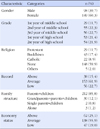Abstract
Purpose
This study examined the fitness of a path model for the relationship among daily life stress, problem of life, social support, depression, and suicidal ideation in adolescents.
Methods
The subjects consisted of 247 adolescents. Data were collected through self-report questionnaires. The data were analyzed by the SPSS and AMOS programs.
Results
Daily life stress, problem of life, social support, and depression showed direct effects on suicidal ideation in adolescents, while daily life stress and problem of life showed indirect effects on suicidal ideation in adolescents. Daily life stress and problem of life showed direct effects on social support and depression in adolescents. The hypothetical path model of adolescents' suicidal ideation was proven correct.
Figures and Tables
References
1. Bronfenbrenner U. The ecology of human development: Experiments by nature and design. Cambridge, MA: Havard University Press;1979.
2. Centers for Disease Control and Prevention. 2007 Young health status on line survey. 2008. Retrieved July 3, 2012. from http://www.cdc.go.kr/CDC/intro/CdcKrIntro0201.jsp?menuIds=HOME001-MNU0005-MNU0011&cid=8849.
3. Chon KK, Choi SC, Yang BC. Integrated adaptation of CES-D in Korea. Korean J Health Psychol. 2001; 6(1):59–76.
4. Conner KR, Duberstein PR, Conwell Y, Caine ED. Reactive aggression and suicide: Theory and evidence. Aggress Violent Behav. 2003; 8(4):413–432.
5. Daniel SS, Goldston DB. Interventions for suicidal youth: A review of the literature and developmental considerations. Suicide Life Threat Behav. 2009; 39(3):252–268.

6. Hawton K, Kingsbury S, Steinhardt K, James A, Fagg J. Repetition of deliberate self-harm by adolescents: The role of psychological factors. J Adolesc. 1999; 22(3):369–378.

7. Hoffman ML. Empathy, its limitation, and its role in a comprehensive moral theory. In : Kurtines WM, Gewirtz JL, editors. Morality, moral behavior and moral development. New York: Wiley;1984. p. 283–302.
8. Hwang Bo SY. A study on the influencing factors on suicidal ideation in adolescents from an eco-system perspective. Daegu: Keimyung University;2011. Unpublished master's thesis.
9. Kang MO. The benefits of social support in the relationship between adolescent group bullying and emotional stability of the victims. Changwon: Kyungnam University;2011. Unpublished master's thesis.
10. Kang SJ. A study on family function of child headed families under the care of relatives. Seoul: Yonsei University;2000. Unpublished master's thesis.
11. Kang SO. A study on the effect of juvenile's depression, social support and stress on suicide thinking. Changwon: Kyungnam University;2010. Unpublished master's thesis.
12. Korea Institute for Health and Social Affairs. Rate of Death on OECD. 2013. Retrieved May 20, 2013. from https://www.kihasa.re.kr/html/tsearch/search.jsp.
13. Kwon EH. A study on the factors influencing the suicide ideation juveniles-focused on psychosocial factors-. Iksan: Wonkwang University;2009. Unpublished doctoral dissertation.
14. Lubell KM, Vetter JB. Suicide and youth violence prevention: The promise of an integrated approach. Aggress Violent Behav. 2005; 11(2):167–175.

15. Matsuishi K, Kitamura N, Sato M, Nagai K, Huh SY, Ariyoshi K, et al. Change of suicidal ideation induced by suicidal attempt. Psychiatry Clin Neurosci. 2005; 59(5):599–604.
16. Mun SB. Basic concepts and applications of structural equating model. Seoul: Hakjisa Publishing Co;2009.
17. Park BG. Factors associated with adolescents' suicidal ideation: Focus on self-esteem and depression as mediators. Korean J Hum Ecol. 2007; 16(3):505–522.

18. Park JS. The effects of school risk factors on suicide ideation in adolescence -With a test the Baumeister' escape theory model-. Daegu: Kyungpook National University;2010. Unpublished doctoral dissertation.
19. Rohde P, Seeley JS, Rohling J, Rohling M. The life attitudes schedule-short form: Psychometric properties and correlates of adolescent suicide proneness. Suicide Life Threat Behav. 2003; 33(3):249–260.

20. Statistics Korea. Cause of death 2011. 2012a. Retrieved July 6, 2012. fromhttp://kostat.go.kr/portal/korea/kor_ko/5/2/index.board?bmode=read&aSeq=260141.
21. Statistics Korea. Adolescents' index 2012. 2012b. Retrieved July 7, 2012. fromhttp://kostat.go.kr/wnsearch/search.jsp.
22. Sanchez HG. Risk factors model for suicide assessment and intervention. Prof Psychol Res Pr. 2001; 32(4):351–358.
23. Shin JE. A study on the psychosocial factors affecting of adolescent's depression. Seoul: Ewha Womans University;1998. Unpublished master's thesis.
24. Smochek MR, Oblaczynski C, Lauck DL, Green PT, Early JA, Smity JE. Interventions for risk for suicidal and risk for violence. Int J Nurs Terminol Classif. 2000; 11(2):60–68.
25. Sung YM. Adolescents' perception of inter-parental conflict and problem behaviors: Social support as a buffer. Kyungnam University: Changwon;2008. Unpublished master's thesis.
26. Worley NK. Mental health nursing in the community. St. Louise, MO: Mosby;1997.
27. Yoo HJ, Han MY. Development of a daily hassles scale for school age children. J Korean Home Econ Assoc. 1995; 33(4):49–64.
28. Yoo JS, Son JW, Nam MS. Factors influencing suicide ideation among adolescents. J Korean Acad Community Health Nurs. 2008; 19(3):419–430.




 PDF
PDF ePub
ePub Citation
Citation Print
Print








 XML Download
XML Download